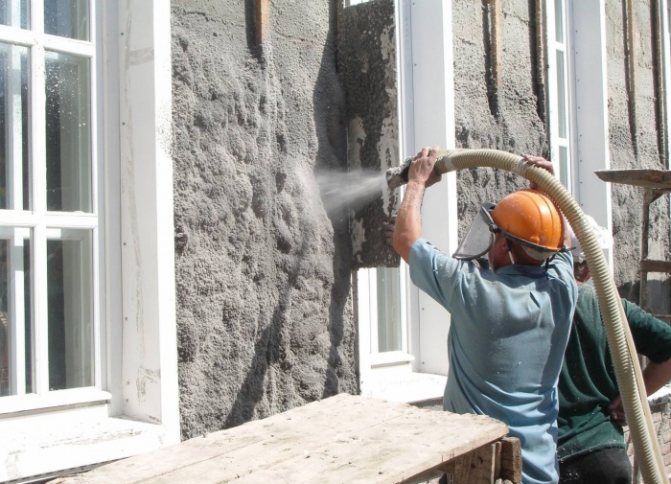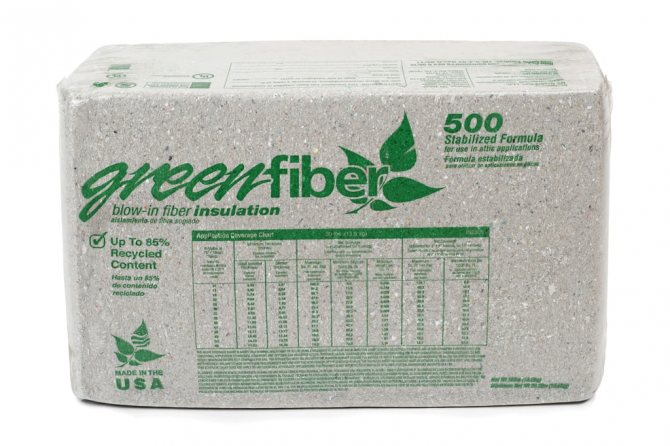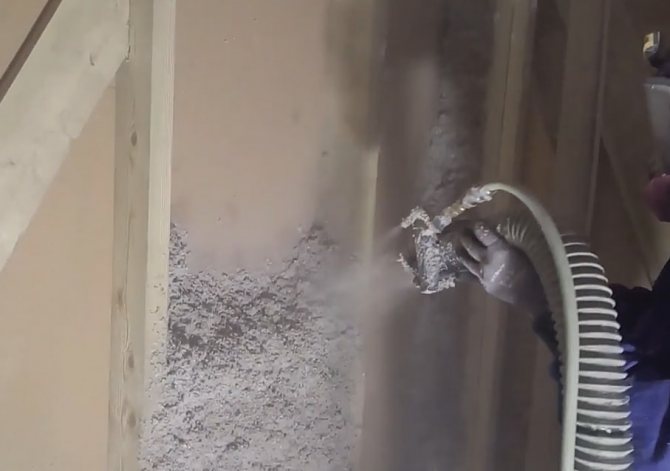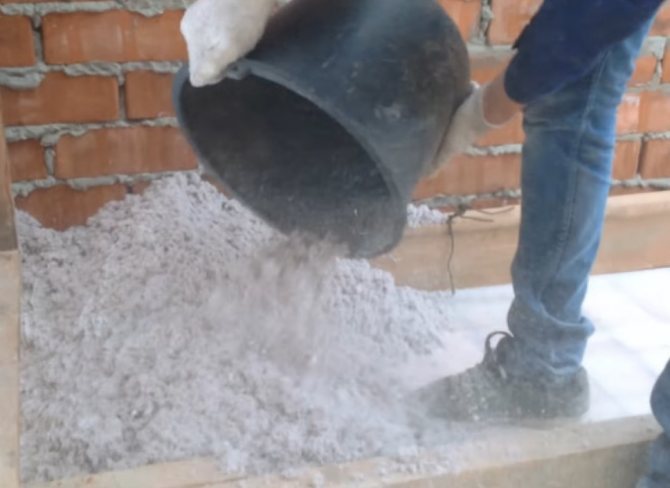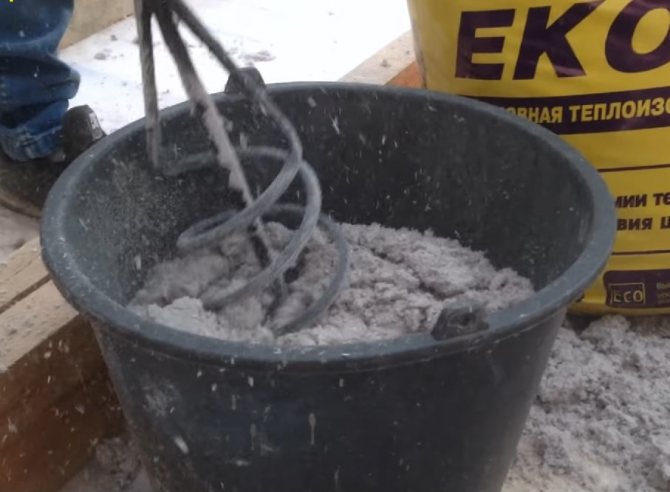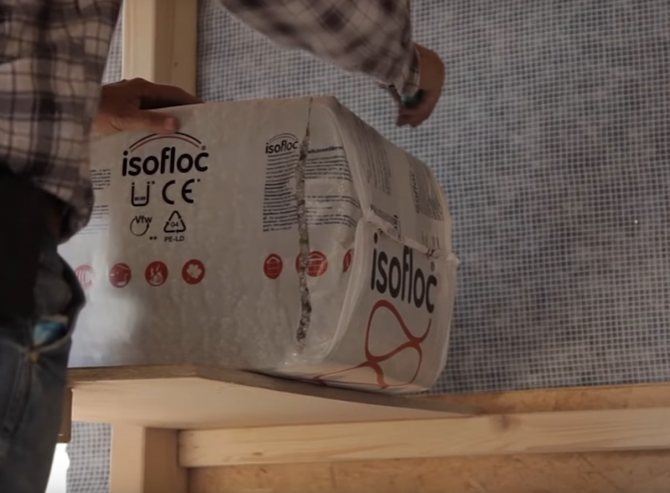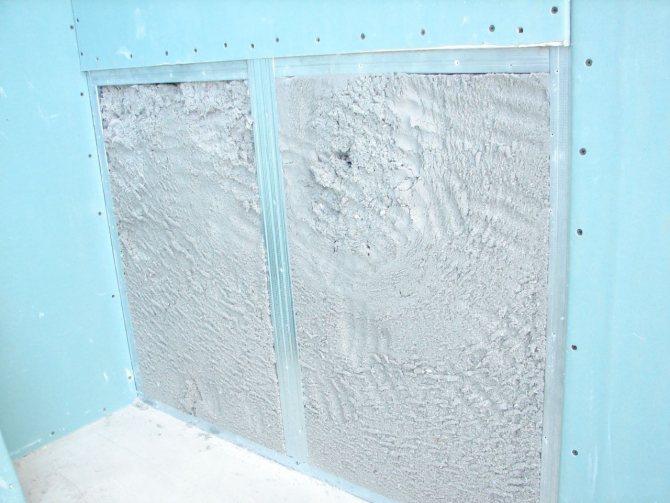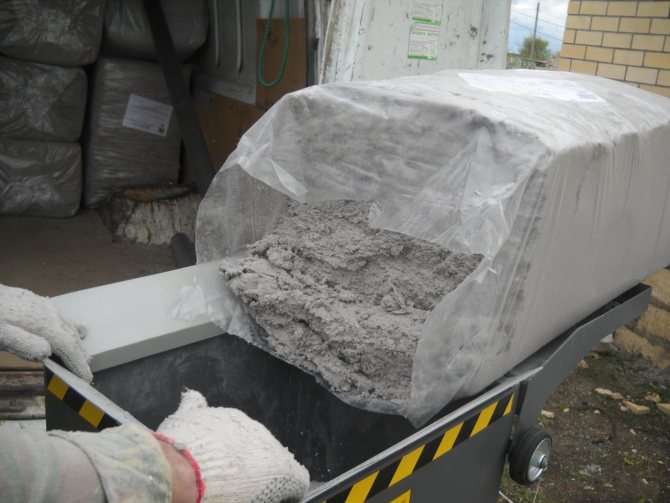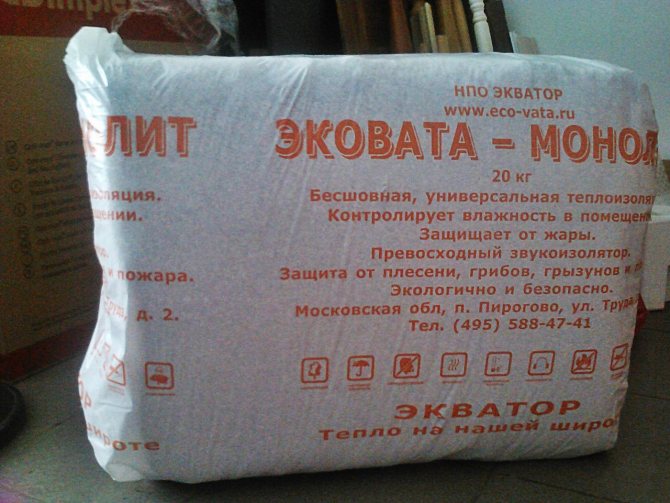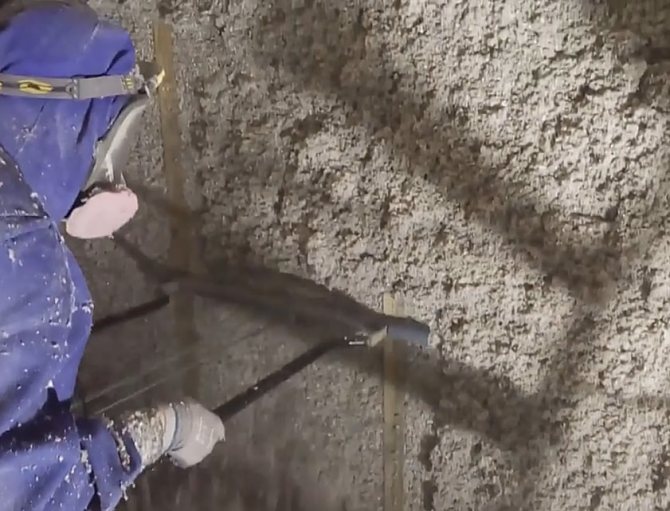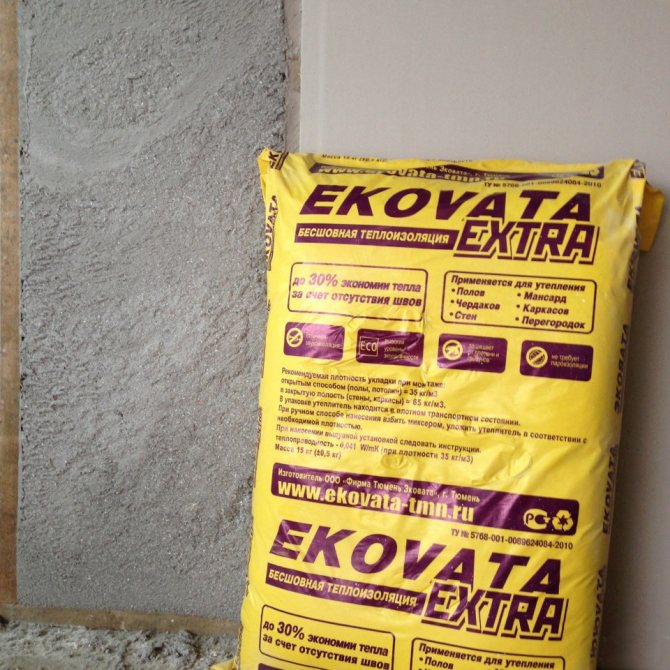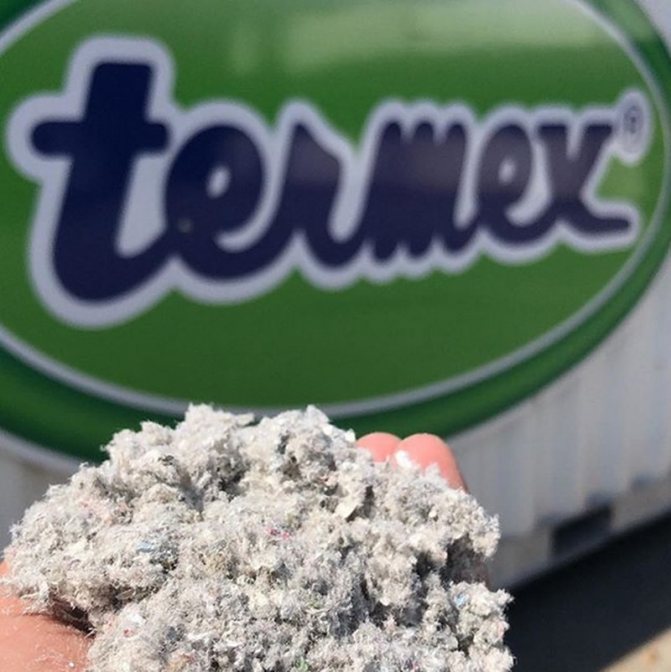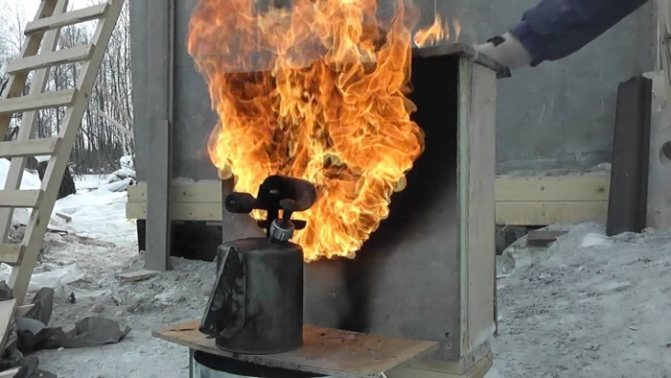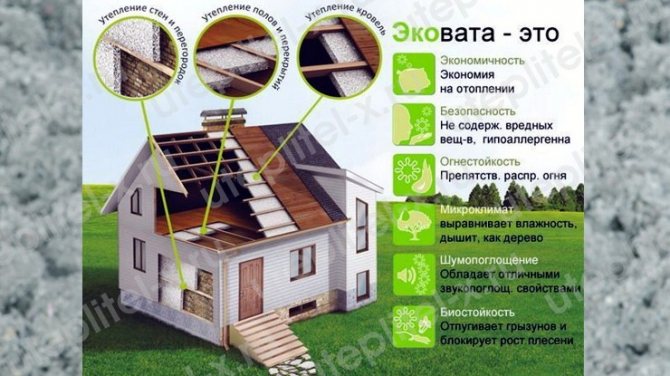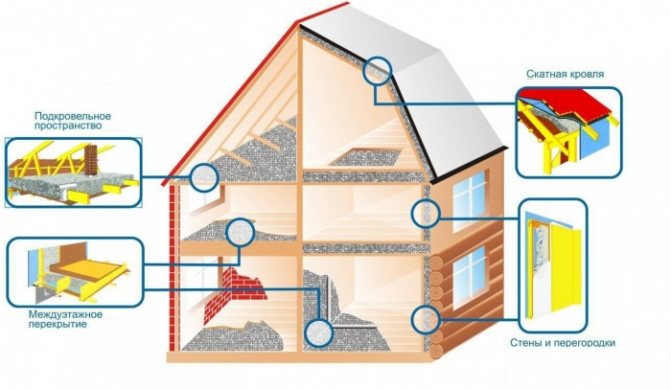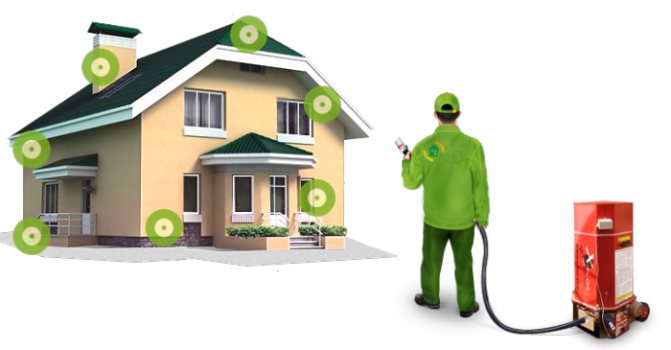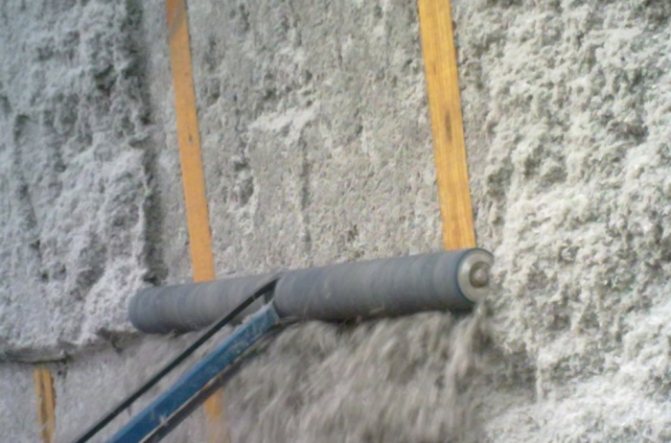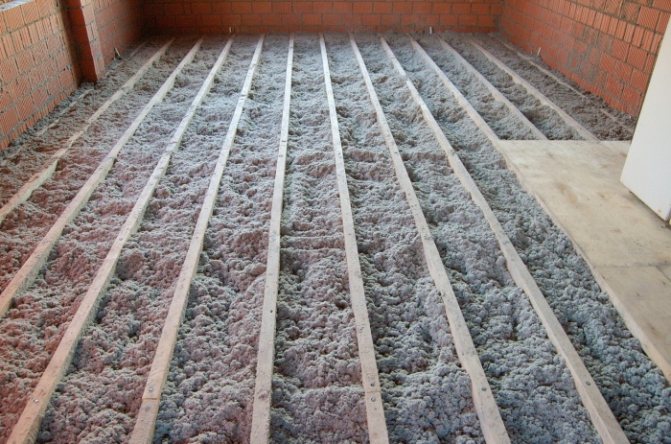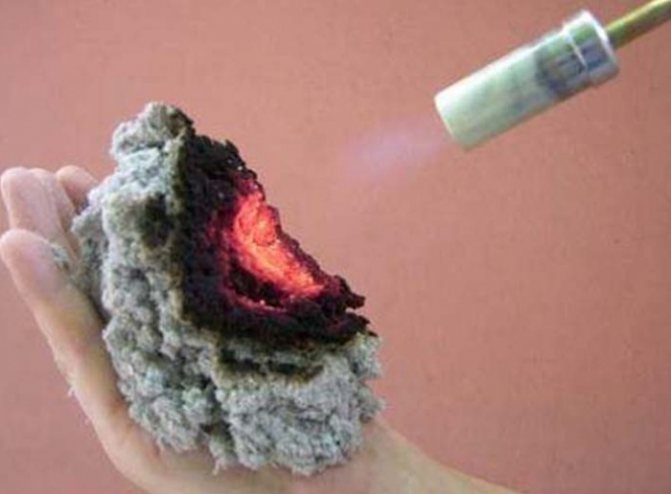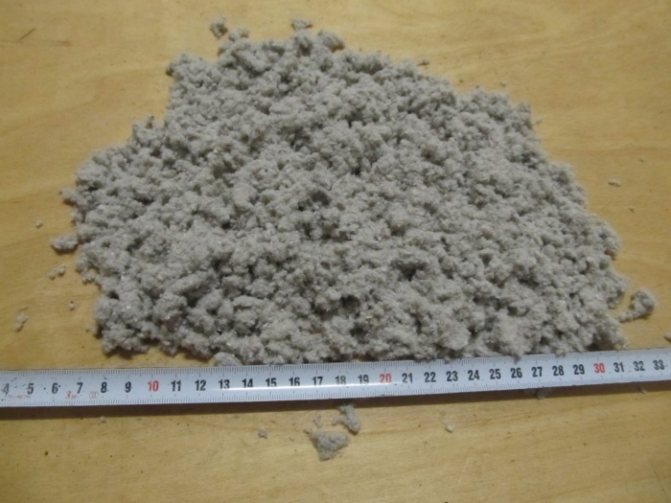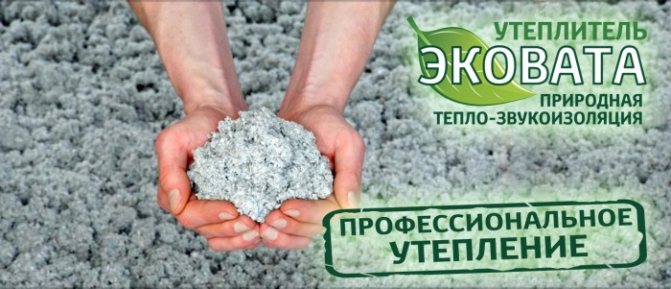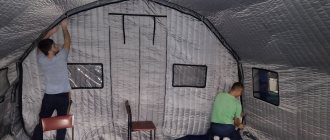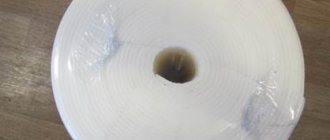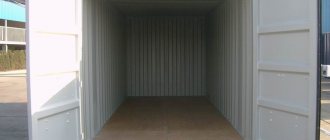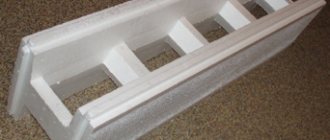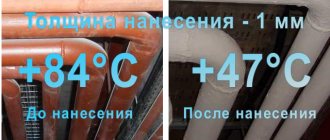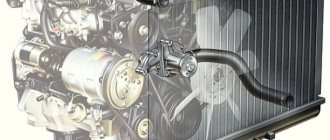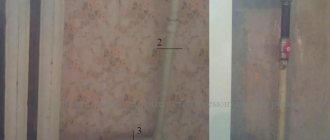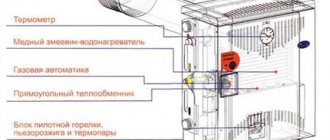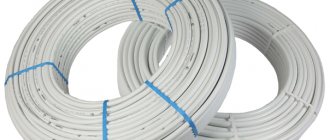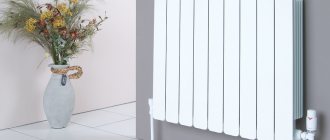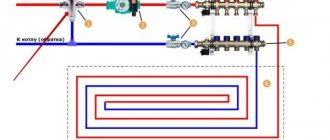What is ecowool, material composition
Ecowool is a cellulose insulation in the form of a loose and lightweight gray fibrous material. Thermal insulation of houses with ecowool is used everywhere today, which is explained by its environmental friendliness. Since the wool itself is highly flammable, manufacturers use various flame retardants for the production of insulated material - substances that prevent the spread of fire. The composition includes substances that are safe for human health, which do not emit unpleasant odors when heated.
The composition of the insulation includes the following substances:
- Up to 80% of the total material is cellulose - this is recycled newspaper, uncoated paper.
- 12% of the composition is allocated to boric acid - this is a powerful antiseptic that prevents the spread of fungi and bacteria inside the insulation.
- 8% is borax, which reduces the fire hazard of the material. Moreover, it is borax that is an obstacle to the reproduction of insects and rodents in the insulation layer.
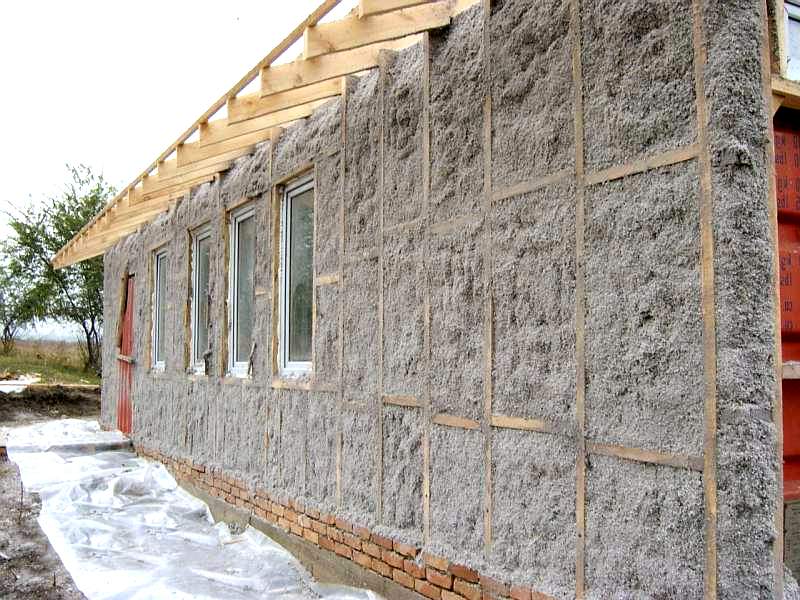
Thanks to the studied composition of ecowool, the low cost of the insulated material becomes clear. There is no toxic component in it, which is why it is allowed to use insulation for the construction of residential buildings.
What is ecowool and how to work with it
Today it is offered in a huge number of materials for thermal insulation of buildings. Every year, manufacturers offer new synthetic and organic insulation, with different costs, structure, strength and thermal conductivity. Due to its environmental friendliness, natural cellulose insulation favorably stands out against the background of new synthetic materials for construction.
Ecowool is a loose material consisting of 80% recycled cellulose and 20% fire retardants and antiseptics. The thermal insulation is laid on the surface to be treated by the spraying method. This material is produced from wood (production wastes are used), waste of cardboard production and waste paper also serve as raw materials for cellulose thermal insulation.
Types and form of production of ecowool
Ecowool today is presented in two forms for delivery - these are bags and pressed rolls. Cotton wool is packed in bags weighing 15 kg, in rolls - with a density of 110 kg / cubic meter. Regardless of how the ecowool was purchased - in bags or rolls - it must be thoroughly fluffed before use. Before use, the insulation should increase in volume by 3-4 times.
There are several types of ecowool, where the ways of using the material are taken into account. In this case, the types of insulation are presented as follows:
- Dry - used only for dry spraying, which will be discussed in more detail below.
- Sprayable - cotton wool is mixed with water and used for wet laying in places. It is used mainly for cladding walls that are not intended for living - hangars, warehouses, production facilities.
- Stabilized - cotton wool with less material consumption, used for dry or wet spraying.
- With oil - used for cladding residential buildings. A small amount of oil is added to the cotton wool, which reduces the amount of dust during operation.
When choosing a type of material for work, it is necessary to take into account the subsequent method of blowing in ecowool.
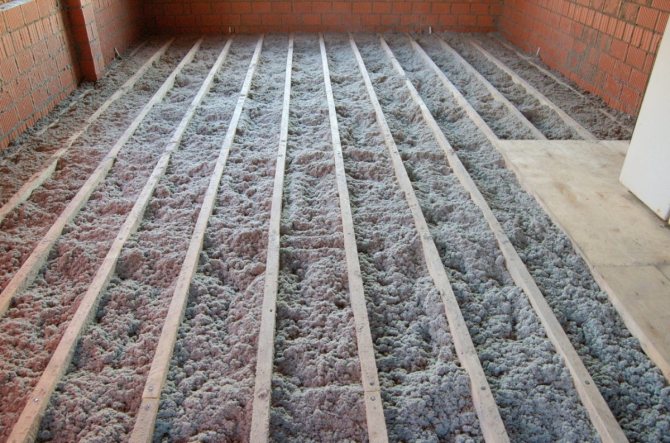

What it is?
Ecowool is a light gray material consisting of cellulose, antiseptics and fire retardants.It is not available in tiles or rolls like other thermal insulation materials.
Due to its characteristic loose, crumbling consistency, it is blown out with air in the cavity, moistened and sprayed onto the surface. Installation is carried out with special equipment. This is done into any wall, regardless of whether it is closed on one side or on both sides.
In terms of thermal conductivity, a layer of sprayed ecowool with a thickness of 15 cm is not inferior to a brick wall of 4.5 bricks. The material is widely used for insulation of residential buildings, various buildings, insulation of attics, mansard coverings.
How to use
Ecowool is thermal insulation of walls and sound insulation of the entire room. Ecowool is used as a heat-insulating material in the following cases:
- in the construction of apartment buildings and private in the formation of floors;
- insulation in all frame structures;
- for warm plaster;
- for multi-layer wall insulation;
- for the reconstruction of an old building.
Since wall insulation is only one of the ways to use ecowool, the following insulation options are distinguished:
- it is recommended to use insulation as a sound-insulating material in the construction of apartment buildings and private ones in ceilings and walls;
- ecowool is used as part of sound-absorbing plaster;
- in any partition walls.
It should be noted that roof insulation with ecowool is used both to increase heat and sound absorption. There are two ways to use the considered insulation - wet and dry.
Wet way Is an industrial method that uses a special blowing machine for spraying ecowool. Recommended for use on brick or block walls. In the process of work, a dense layer is formed - about 60 kg / cubic meter. The material is pre-wetted with water or a special adhesive lignin. The application method is fast, but there is a drawback in the form of the obligatory use of expensive blowing equipment for blowing ecowool.
Dry method - This is a manual method of wall and roof insulation, where cotton wool is laid out by hand or by a compressor. A method is used to insulate or improve sound insulation of small buildings, including private houses. The material is preliminarily fluffed with a drill with a nozzle for a solution until the volume increases by 3-4 times, as mentioned above.


Styling features
There are the following main methods of insulating buildings with ecowool:
- wet;
- wet glue;
- dry.
The spraying of cotton wool with a special installation improves the quality and uniformity of the coating and, at the same time, reduces material consumption.
Wet
The method is used for walls and other vertical surfaces.
In this case, compositions such as PVA or lignin of natural origin are used as glue. Moistened fibers adhere well to walls. In this case, a monolithic insulating layer is formed with a density of 50 to 65 kg / m3.
Cotton wool, moistened with water without glue, is also well applied and distributed along the wall, but there is a risk of its precipitation during prolonged use.
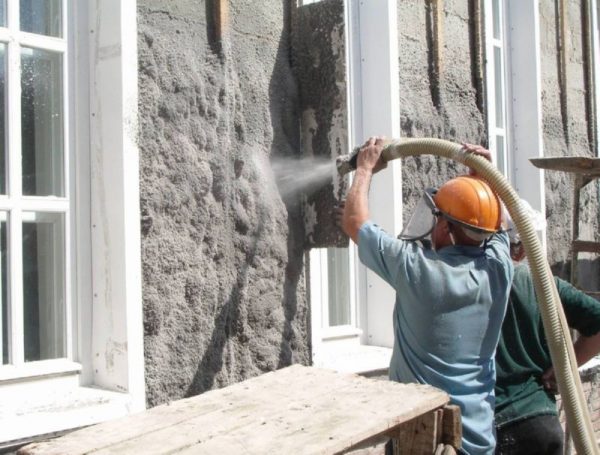

Wet glue application
Excess cotton wool can be cut off with a construction knife, crushed and reused.
Dry method
The fluffed cotton wool is poured into the sinuses until it begins to spring when pressed by hand. It is better to fluff cotton wool in a large tank or a construction basin. To estimate the mass of the required material, it is enough to calculate the volume of the cavity to be filled, and multiply it by the standard filling density.
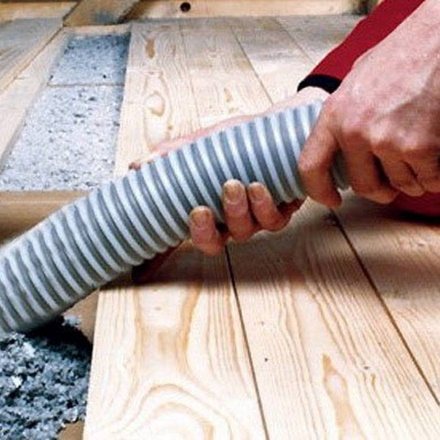

Dry blowing
For vertical surfaces, the recommended density is 65 kg / m3, for horizontal surfaces, 45 kg / m3 is sufficient.
Industrial way
The method requires the use of a special fan, which conveys the fibers to the application site through a sleeve under low pressure.Provides an even distribution of fibers. Allows you to wet the fibers with adhesive or water when using wet or wet-adhesive application.
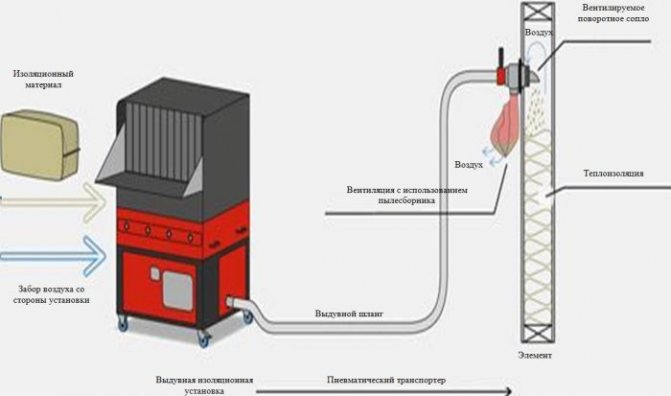

Industrial unit operation diagram
For blowing, technological holes or openings with a width of at least 10 cm are left. At the end of the application, they are sealed.
With your own hands
Household-class installations cost from 20 thousand rubles. But you can do it yourself, manually pouring the material. In this case, it will be necessary to strictly observe the technology, first of all - the amount and density of application.
Fibers, previously fluffed in a spacious container, are simply poured onto horizontal surfaces and leveled. For loosening, you can use a construction mixer at minimum speed.
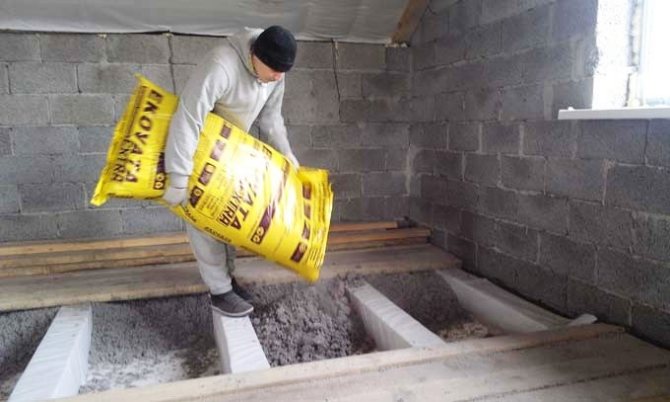

Backfilling manually
To insulate vertical surfaces, cotton wool is poured into the prepared cavities between two walls until the material begins to spring when pressed by hand.
The method is good for small volumes of insulation or repair work, insulation of a change house or shed. It will be easier to buy or rent an installation to insulate an entire house.
Pros and cons
Manufacturers claim that ecowool insulation is an unconditionally ecological material that is recommended to be used everywhere for insulating walls and ceilings, improving sound insulation. But upon a detailed examination of the characteristics, certain pros and cons of ecowool are formed, which should be considered when choosing a heater.
pros
- Low moisture permeability. Humidification of a simple insulation leads to a loss of heat several times, which makes its use ineffective. As for ecowool, in this case, moistening it by 25% leads to a loss of heat by only 5%, which makes its use useful and financially profitable.
- Seamless insulation. In order to use rolled insulation, avoiding cold bridges, at least 2-3 layers of material will be required - this is financially costly. Ecowool fills all the voids, which makes its use easier and more financially profitable.
- High performance of noise absorption. It is an excellent material for absorbing sounds, therefore it is recommended to use ecowool for the construction of residential buildings located on busy streets and near the roadway.
- Affordable price. With low consumption, this material becomes affordable for all segments of the population.
Minuses
- Complexity of installation. It is necessary to fill all the cracks with material, for which it is necessary to blow out the ecowool. And this requires special equipment. You have to call a team of workers and pay for their work.
- Waste of time. The presented drawback, first of all, relates to the wet method of laying the insulation. In wet application of ecowool, its complete drying is required, which takes at least 3 days.
- Low material rigidity. In comparison with foam, this material has a low rigidity, which requires additional construction of the frame.
- Shrinkage of the material. Already in the second year of operation of the building, the insulation shrinks when it is placed vertically.
- Combustion of material. It is a mistake to believe that ecowool does not burn at all. It does not burn, but smolders, which creates a risk of ignition of nearby materials.
It follows that ecowool is a specific material that requires adherence to the recommendations, both in use and in subsequent operation.
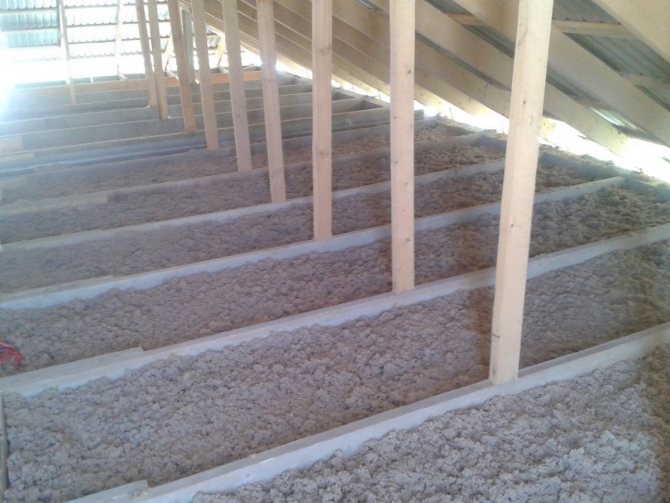

Ecowool - technical characteristics and installation
Appearance of material, brief description


Video about ecowool
The material began to be produced in Germany in 1928. After World War II, active construction began in Europe, new house-building technologies developed, which contributed to an increase in demand for building materials and interest in inexpensive ecowool. Now the material is popular in Japan, Canada, USA and Europe.In the Russian Federation, they learned about insulation recently, but it has already managed to gain popularity.
Ecowool - technical characteristics:
- High density;
- The thermal conductivity of ecowool is high;
- Moderately flammable;
- Non-flammable, produces little smoke in case of fire;
- Low breathability;
- Low vapor permeability;
- PH level - 7.8 - 8.3;
- Chemically passive material that does not corrode adjacent elements;
- Sound absorption 63 decibels with a material thickness of 50 mm;
- The material does not shrink, as it is springy and adheres to metal, wood, brick and glass;
- Experts have confirmed the hygiene of cellulose wool, it does not cause allergies, is absolutely clean and harmless;
- Mounted by spraying, closes all cracks and hard-to-reach places, creates ideal insulation;
- Excellent manufacturability: simple installation, immunity to low temperatures - they work with ecowool even in winter.
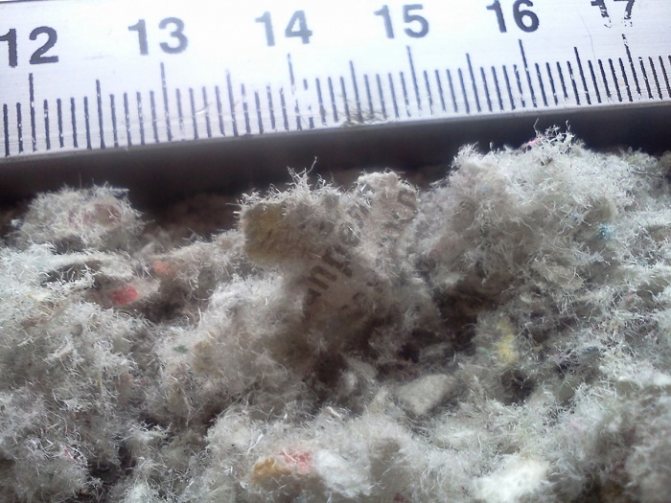

The main advantages of ecowool
- Excellent thermal insulation - the coefficient of thermal conductivity is at the level of the best world heaters (used in the construction of baths).
- Low air permeability: small-sized wood fibers allow even a thin layer of ecowool to retain heat. Heat transfer is minimal.
- Seams and voids are excluded: ecowool lays down in a continuous insulating layer, which is impossible with classical insulation with solid or roll materials. The result is the highest quality insulation.
- Sound insulation of a high level: for example, a small layer of ecowool creates a sound absorption coefficient of 63 dB, but a dense layer of drywall with cotton wool retains 37 dB.
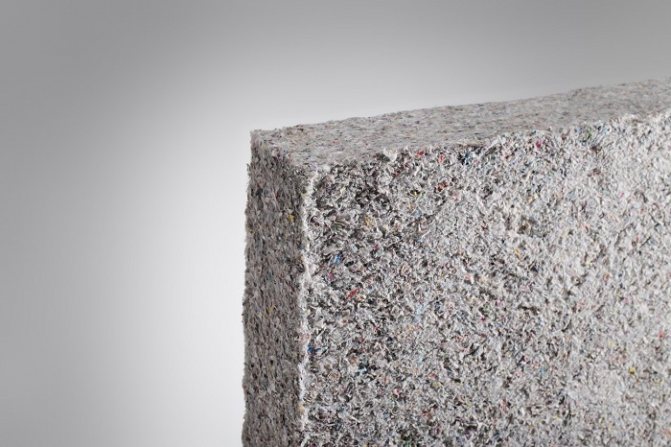

- Moisture resistance: the material is able to absorb and release the accumulated moisture without losing its main characteristics. The capillary structure of the cotton fibers prevents condensation and water droplets from accumulating. Water flows out through the cellulose capillaries. In winter, steam does not turn into condensate - no additional coatings are required against its formation. No steam isolation required saves money and minimizes work.
- Environmental friendliness of the material: the insulation is made of natural non-volatile components that do not cause allergies and diseases. No toxic gases are emitted during a fire.
- The fire retardant in the material has raised the level of fire safety to the maximum. Ecowool does not support ignition and prevents its spread: salts and fibers contain moisture and water, which, when released, extinguishes the fire.
- Long service life and resistance to external influences: borax and salts protect cotton wool from destruction by microorganisms, protect it from rotting and mold. The strength of the materials is preserved, and rodents do not start inside. The warranty period for ecowool is 50-80 years if used correctly.
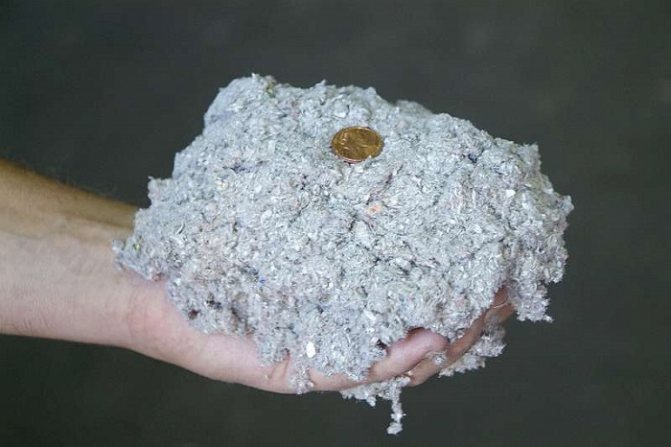

- The insulation material is very easy to apply, it allows you to work not only during construction, but also during the reconstruction of buildings.
Read more about soundproofing. Sound is transmitted through gaps and crevices in floors and walls. Ecowool creates a wall of sound insulation, filling all cracks and gaps. The fibrous structure of the material helps to penetrate even the smallest voids.
The main indicator of sound insulation is the external noise absorption index, expressed in decibels. The index is measured in terms of the frequency response of noise absorption by the fence.
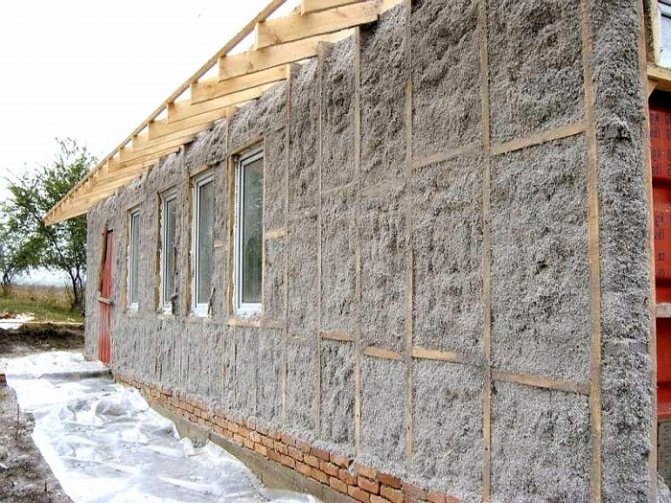

The normal sound absorption index for partitions, houses, educational institutions, hospitals, recorded in the RF Code, is 60 decibels.
We draw conclusions: to achieve the optimal sound absorption index, it is enough to lay out a 50 mm layer of ecowool.
About fire-fighting properties
Investigating the fire-fighting properties of ecowool, experts conducted an experiment - the roof of one building was insulated with ecowool made of plywood, and the second building was covered with a glass fiber insulation. Inside, near the roof, a fire was placed. After 5 minutes, the fire had already broken through the fiberglass to the outside.After 20 minutes, the second building practically burned down, but the one insulated with ecowool itself extinguished the fire.
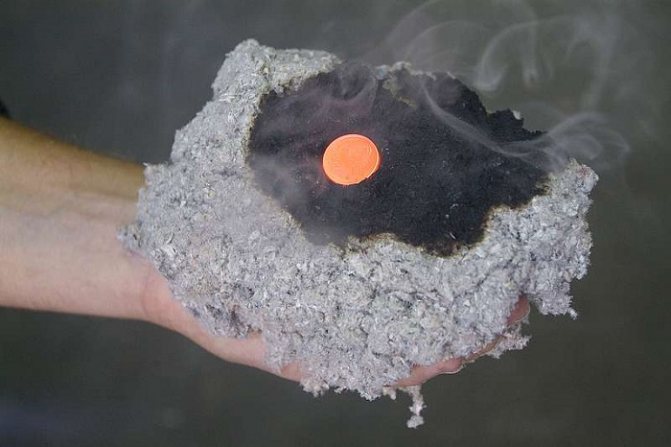

During a fire, the fire carbonizes the outer part of the ecowool, which, under the influence of heat, begins to release water and extinguishes the fire. The low level of air permeability and the dense crust of ecowool block the access of oxygen to it. The fire penetrates at a scanty speed of 1-2 mm per minute. Plasterboard partitions insulated with ecowool have increased fire resistance. The combustion does not extend into the depth of the material, but remains at the top. The top layer of burnt cellulose breaks down into water and carbon monoxide, so the material does not emit toxic substances into the atmosphere.
7 cons of ecowool
- Good thermal insulation and thermal conductivity decrease over time under the influence of such factors. During operation, ecowool reduces its weight by 20%. Experts advise to lay the material in excess of 20-25% in order to avoid problems with operation in the future. Ecowool absorbs moisture well - by 9-15%, and its moisture content increases by 1% per year. With each percentage increase in humidity, the level of thermal conductivity increases by 2.5%. Therefore, for thermal insulation, you need to do ventilation - to give the opportunity to release moisture into the atmosphere.
- For installation, you need innovative expensive equipment - pneumatic devices that carry out high-quality installation of ecowool. Only modern equipment creates the required injection rate and coating layer to further avoid shrinkage.
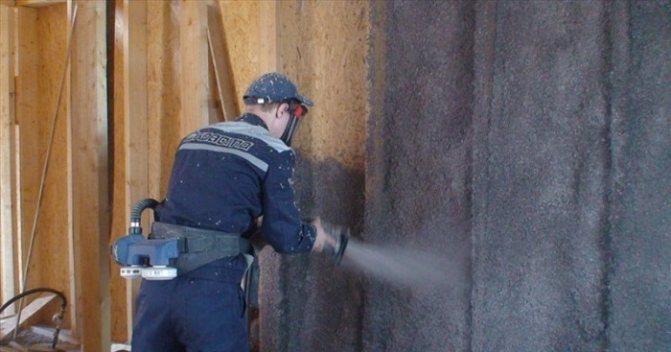

- For proper installation, qualified specialists with experience in working with ecowool are needed - the material is very picky and requires handling skills.
- When installed dry, the material can form dust, and when wet, it can take a long time to dry. Ecowool can dry from 2 to 3 days - it all depends on the weather conditions and the level of humidity in the region where the work is taking place, sometimes drying takes longer. This is the biggest lack of material, because often there is not much time for construction. It is wet laying that gives the best result: the material is compacted and dries evenly, which ensures a high level of sound and heat insulation of the room.
- If we compare ecowool with expanded polystyrene plates, then it has a low level of rigidity, which makes it impossible to use the material as an independent insulation when installing floor screeds.
- If we carry out insulation work in a vertical base and do not make the density of the insulation of the required norm - 65 kg / m2, then shrinkage will occur in non-insulated places.
- Builders advise against using ecowool near open flames, pipes, stoves, fireplaces. Due to the constant exposure to heat, the insulating material begins to smolder. To protect ecowool, special coatings made of asbestos and cement, refractory mats made of basalt, surfaces with foil to reflect heat are adapted - all these are unnecessary costs and work.
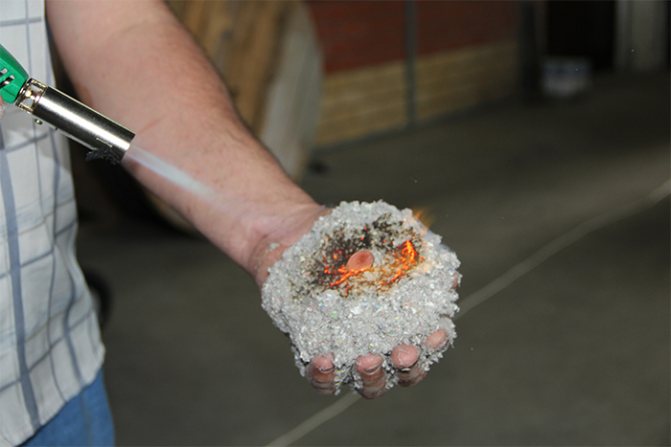

How much does ecowool cost
The video shows the production of ecowool
The main characteristics of the material for construction are the optimal ratio of price to quality + cost of installation work. A cubic meter of material today costs up to 4000 rubles (for 2014). One cube. m includes 120 kg of material. During installation, the material increases its volume by 2-3 times.
Ecowool has no competitors in terms of price-quality ratio. The material is not so popular in the Russian Federation for several reasons: untimely appearance in an unfavorable period for construction (90s), far-fetched complexity of installation work, high price at the beginning of sales, expensive installation equipment.
From the point of view of Russian users, ecowool is a novelty on the market, the technical characteristics of which few people know. According to statistics, 90% of users are now waiting for the materials to be supplied by a neighbor, so that later they can be convinced of its quality using someone else's example.Note: residents of the USA, Europe and Japan have been using insulation for more than a century, and it is unlikely that our neighbors, capitalists, who are accustomed to comfort, would use material with poor technical characteristics. Ecowool, whose characteristics are almost ideal for economical and high-quality construction, undergoes several strength tests every year.
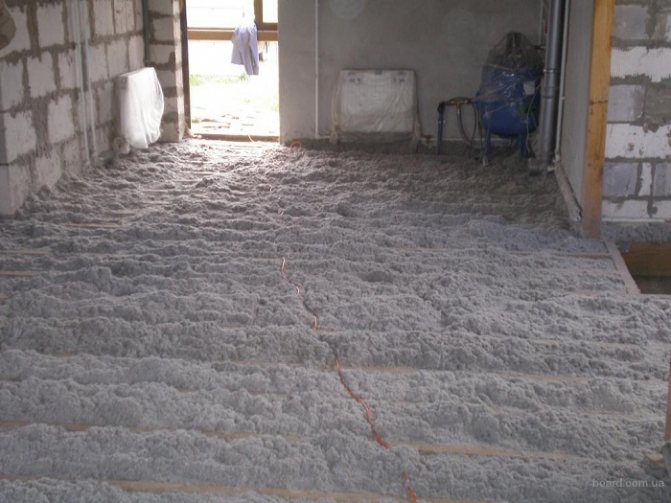

In terms of its characteristics, ecowool is not inferior to wood and cellulose wool; during installation, a tight-fitting layer of insulation is obtained, which ideally protects against cold and sound.
Ecowool is a cellulose insulation that does not change its main characteristics even at a dampness level of 20%. (Ecowool packaging contains up to 10% moisture, so the best way to apply it is wet).
The best thermal insulation is provided only by installation with professional equipment.
- Author: Yana
Rate the article:
- 5
- 4
- 3
- 2
- 1
(1 vote, average: 1 out of 5)
Share with your friends!
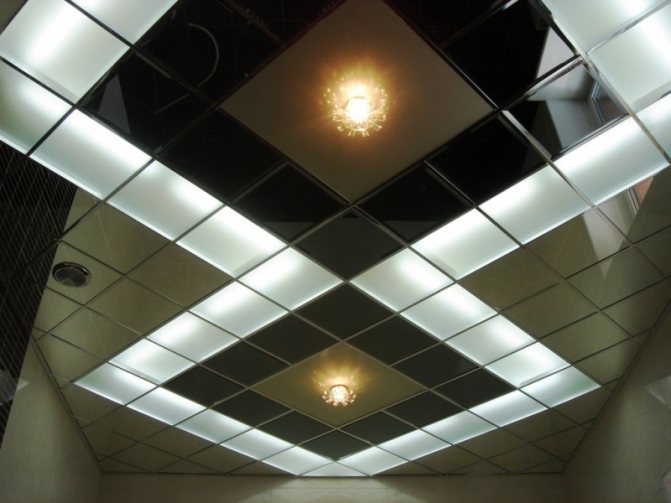

How to calculate the Armstrong ceiling and the main technical characteristics
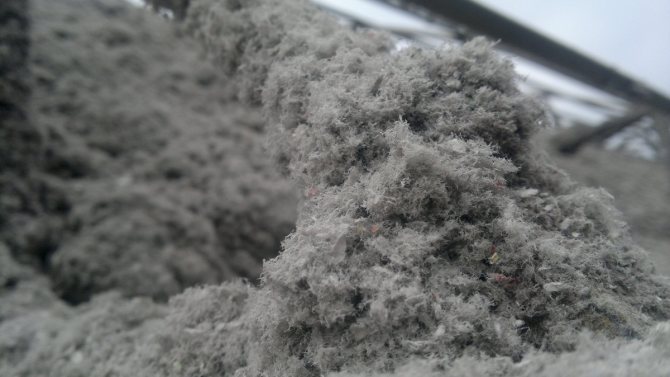

Equipment for ecowool - do it yourself installation
Step-by-step instructions for thermal insulation with ecowool
Do-it-yourself insulation of an ecowool house or other building occurs in the following sequence:
- In a basin or other large capacity, it is necessary to beat the ecowool with a construction mixer.
- Pour insulation onto the subfloor between the logs.
- Smooth the ecowool with a mop so that it clogs all the cracks in the floor evenly.
- Next, proceed with the installation of the floor or wall, immediately stuffing the boards.
Attention! It is forbidden to step on the insulation, since in this case it loses its properties.
The walls are not insulated with ecowool from the outside, but they are done from the inside. For this, one OSB slab is installed in the second layer inside the building - in one row from the floor. Ecowool is poured into the gap between the two slabs, crushing it slightly with your hand.
Disadvantages of ecowool
The main drawback of the material is that special equipment must be used for high-quality installation. The installation is carried out using inflatable pneumatic installations. The mechanical method of application is essential for the ecowool to work 100%.
High qualifications are required from the specialist performing the work. With an illiterate and inept use of ecowool, a significant decrease in the effectiveness of insulation occurs.
Important! The material is not recommended for use in the immediate vicinity of chimneys, chimneys and other sources of open fire. High temperatures are dangerous because ecowool under their influence begins to smolder (not burn). In this regard, additional fences are required.
Minusekovaty and the fact that it dries for a long time after installation. Depending on the weather conditions, this can take up to 72 hours. It is not very convenient with a tight deadline.
In some cases, ecowool can shrink. For example, if open free backfilling of ceilings was carried out or the requirements for installation density were not observed.
Consumers should keep in mind that in Russia there is no GOST for the production of ecowool, so a lot depends on the manufacturer. No one is insured against the fact that a low-quality product comes across.
Do mice gnaw ecowool?
As you know, rodents love cellulose fiber, from which ecowool is produced. But they do not settle in it, and, moreover, do not gnaw at it. The whole secret lies in the content of an antiseptic, orthoboric acid, which rodents really do not like. Getting into ecowool, they begin to feel discomfort, feel thirsty and leave it in search of a more comfortable place. In this way, antiseptic helps to create an environment that is not favorable for mice and rats.
Ecowool is a durable and versatile material for thermal insulation. Using technological equipment, you can insulate any premises in the shortest possible time.Reasonable price, excellent properties, environmental friendliness - these are just some of the characteristics that make the material so popular.
User reviews
Reviews of wall and floor insulation with ecowool are positive. But in this case, they clarify the insulation of farm buildings, sheds, garages and small private houses. It is somewhat more difficult to insulate multi-storey buildings or private 2.3-storey buildings with ecowool manually. It is necessary to use the services of professionals who work with the use of special equipment.
The characteristics and properties of the insulation correspond to the declared information by the manufacturers. Most people note the real absence of mold, rodents and insects in the house, even if it is built of wood or OSB slabs.
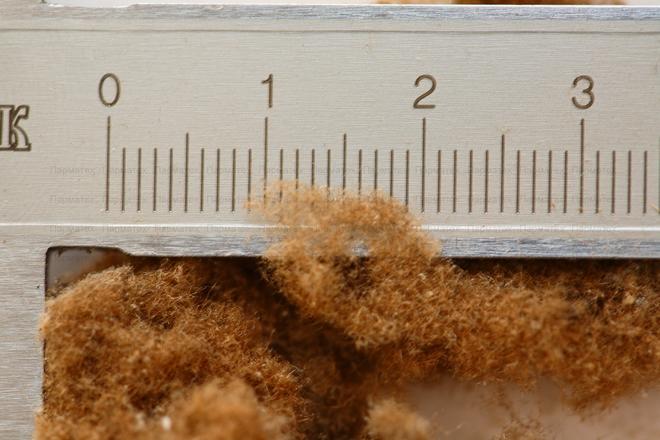

The advantages of ecowool over mineral wool
The main advantage of ecowool over mineral wool is that the material is not afraid of moisture, it is able to absorb moisture and quickly release it, so it is practical to use it where there is high humidity or there is a possibility of condensation. Any, even the highest quality mineral wool, for example, URSA, requires protection from moisture, since when mineral wool gets wet, its thermal conductivity increases.
Ecowool is applied using special equipment, which allows to increase the speed of work. This is a big plus, in contrast to the use of mineral wool for thermal insulation. In addition, the sprayed insulation can penetrate into any crevices and niches, creating a continuous heat-insulating layer without gaps on the treated surface.
Customer Reviews
Here is what Sergei, from the city of Penza, said: “I thought for a long time how to insulate the house. I decided to use ecowool, as I compared roll-type heaters. I realized that everything will cost both cheaper and better. And so it happened. Ekovata does its job perfectly. I didn’t find any minuses ”.
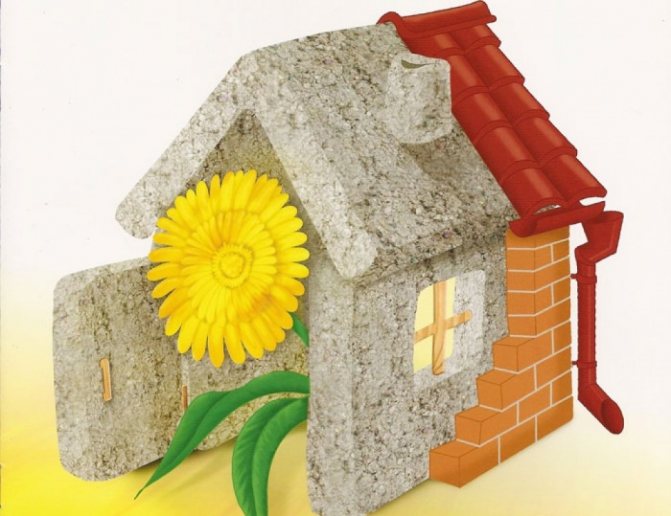

But Victor from St. Petersburg writes: “The insulation is bad! As it turned out, it is simply impossible for those who are allergic to library dust to live in a house insulated with ecowool. Out of the 3 years that I arrived at the house, I suffered from urticaria for 2 years.
Igor shares: “I am satisfied with the quality of insulation with ecowool. For 4 years of operation, everything is fine. The only moment, I recently opened the boxes and found that the ecowool had sagged a little. It is possible that mistakes were made during the installation. "
